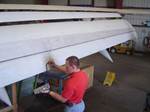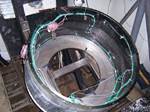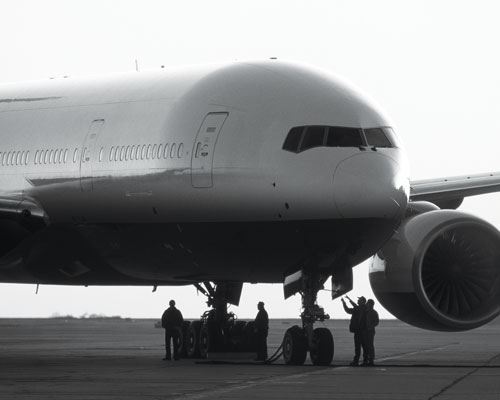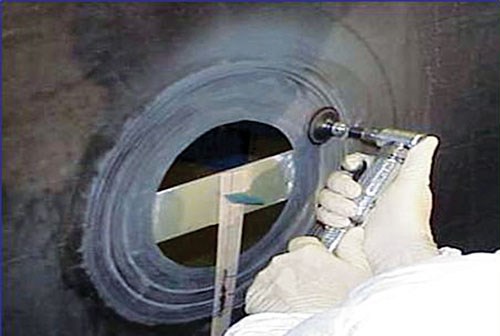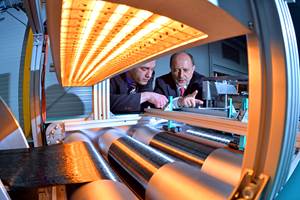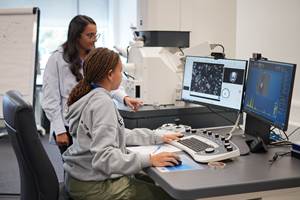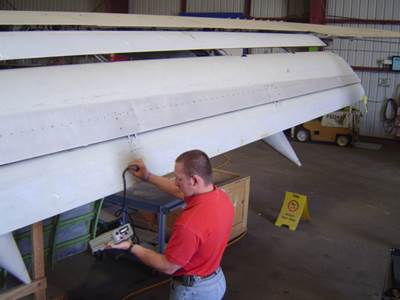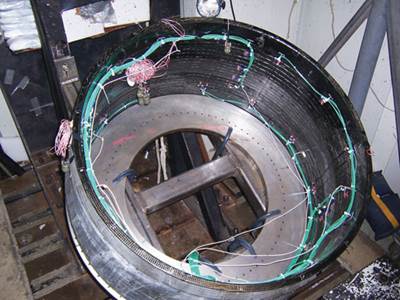In-situ composite repair builds on basics
For on-aircraft repair, demand is on the rise for specialized composites training and expertise.
The goal of any commercial aircraft maintenance and repair crew is the fastest safe return of the aircraft to service — especially in view of the fact that the cost in lost revenue of an unscheduled AOG (aircraft on the ground) is, on average, $100,000 per day. No wonder, then, that in the run-up to the launches of the Airbus A380 and Boeing 787, much has been made of airline and maintenance and repair organization (MRO) concern about how aircraft composites would be repaired. Considering that the average permanent composite repair, as permitted in Structural Repair Manuals (SRMs), takes roughly 15 hours, according to SAE’s Commercial Airline Composite Repair Committee (CACRC), in-situ composite repairs performed at the flight line can cause flight delays and cancellations. It’s a dilemma made more challenging by fast gate turnarounds — between 30 and 60 minutes for domestic flights — and an overwhelming lack of line mechanics with specialized composites training. But aircraft OEMs, airlines and MROs are crafting strategies to minimize ground time, simplify repair regimes and make composite materials and processes accessible to technicians who are more accustomed to working with metals.
Repair readiness
According to Mark Loyd, lead engineer of composites, plastics and transparencies at American Airlines’ Composite Repair Center in Tulsa, Okla., one of the chief obstacles is logistics. “Our in-situ problems are like real estate,” he muses. “Everything is location, location, location — location of the airplane, location of the people and equipment, location of the repair material and location of the damage. We have to weigh flying a crew, materials and equipment to a station to do a repair or obtaining a spare part and replacing it, or ferry flying the airplane to a maintenance base for part replacement.”Access, equipment and the ability to handle the part are critical, explains Loyd. “Obviously, the shop environment is much better equipped, with better vacuum systems, grind booths, constant air supply and shop supplies like bagging film, sealant tapes, etc.,” he adds. On the flight line, however, equipment and processes are strictly controlled to guard against potential fire hazards created by the presence of fueled aircraft (for more on flight line curing options, see the sidebar, below). “The properly executed in-situ repair requires far more advanced planning,” says Loyd. “Once deployed for the repair, you can’t afford wasted time for resupply.”
Unscheduled repairs
The most disruptive repair situation, in terms of downtime, is the unscheduled repair. Impact damage, hail damage, and moisture ingress/intrusion are the most common types of damage to composite structures that cause an aircraft to be taken abruptly out of service. “Operators all face the same issues regarding repair materials, spare part inventory and equipment location,” says Loyd. Most repair materials have a finite shelf life, and MROs perform a balancing act to keep adequate repair materials on hand without having extremely high material waste. Each operator must forecast material use well in advance because “currently, lead times of more than 20 weeks are not uncommon,” says Loyd. “Operators with multiple fleet types often face the challenge of stocking multiple types of the same material, such as three different types of 350°F/177°C carbon fabric prepreg.”Currently, the predominant in-service composite aircraft components are sandwich-structure control surfaces cored with honeycomb or foam. In general, the repair techniques used on them have been around since composites were first used in aircraft. “We’ve not experienced any ‘game-changing’ repair materials or techniques in quite a while,” says Loyd. “The OEMs are allowing increased use of elevated-temperature wet layup repairs, but the repair methodologies used today are very close to what they were a decade ago.”
For permanent repairs, wet layup bonded repairs must be cured at 180°F/82°C to 200°F/93°C. Prepreg repairs, which can be used to repair thinner sandwich panels as well as the thick solid laminates common to the load-bearing structures on both the Boeing 787 and Airbus A380, cure at temperatures ranging from 250°F/121°C to 350°F/177°C and are generally left to composite specialists at major repair stations (see “Learn More”).
Repair options for thicker laminates
Boeing has spent considerable effort attempting to make the 787’s solid laminates less susceptible to the dents and dings associated with hail damage, tool drops and jetway impacts that plague thinner composite structures. The company has performed extensive research in damage probability, calculating energies associated with everything from the corner of a toolbox striking an upward facing structure to the impact of a jetway on a cargo or passenger entry door. “We’ve tried to correlate the damage that we see today and the repairs that are required and translate that into impact energy,” explains Justin Hale, Boeing’s chief mechanic for the 787 program. “The result has been new sizing for upward facing structures and structures around doors to make the airplane more resistant to damage.”Damage will occur, however, and when it does, the first step is to assess if and how much internal damage there is within the laminate, which will require ultrasonic inspection, says Hale. Yet, when a small dent is noticed during visual inspection at the gate, performing ultrasonic testing can be time consuming, and will require a technician with specialized training. “When you have a small impact damage, the SRM will provide allowable damage limits, based on the dent size,” explains Hale. “But if you can characterize what’s going on inside that structure by assessing delamination, these limits are more generous in allowing you to dispatch the airplane.” To aid in this process, Boeing developed the Ramp Damage Checker — a simple “go/no go” handheld device (similar to a stud finder) that identifies the presence of delamination. “It’s not intended to provide detailed information, such as depth, but it can confirm the presence of delamination,” says Hale. “We en-vision it being used in the field by a maintenance lead or inspector — not necessarily an ultrasonic specialist.” The first commercial Ramp Damage Checker is now available from Olympus NDT (Waltham, Mass.). Other brands will follow.
Bonded repair of a solid laminate panel is similar to that for a sandwich structure. “These are very traditional vacuum-debulked bonded repairs,” stresses Hale, which include 250°F/121°C to 350°F/177°C prepreg repairs as well as 200°F/93°C wet layup repairs. Repair times may increase when multiple cure cycles are needed for thicker structures or if extensive repair is necessary. The general rule of thumb for scarfing is to remove 0.5 inch/13 mm per ply. “Ply thickness varies depending on the materials used in the original structure, but for carbon fiber unidirectional tape, it can be as thin as 0.13 mm/0.005 inch,” says Michael Hoke, president of Abaris Training Resources Inc. (Reno, Nev.). “A 0.375-inch/9.525-mm thick structure could be approximately 75 plies thick.” By the standard rule of thumb, this would translate to a scarf of ~37.5 inches/~952.5 mm.
“Such a large scarf would be very time consuming,” says Hoke. “On a structure this thick, a bolted doubler repair, if allowed, would be much quicker and generally easier to perform. However, there may be aerodynamic reasons, concerns about damaging the underlying structure during drilling, or radar signature reasons in military aircraft, which would require a scarfed repair,” he adds.
With a smaller scarf, less undamaged material is removed but the area of the adhesive bond, which transfers load through the repair plies, also is reduced. “There are many tradeoffs in repair design,” says Hoke. “The scarf angle is only one of many such tradeoffs that need to be carefully evaluated by a qualified repair design engineer.”
The quick composite repair is not permanent, but rather a “Band-Aid” designed to get a damaged airplane back into service quickly. “The precured composite patch is epoxy bonded onto the outside of the airplane over the damaged area,” explains Hale. “It restores enough residual strength into the damaged area to provide revenue service on a temporary basis.” The process allows small-area damage to be repaired in less than an hour. The adhesive is cured by relatively low temperatures provided by a chemical heat pack, which eliminates the need to dry the part, and is designed to be applied at the gate if necessary. “This is very important if you don’t have widespread repair capability throughout your system,” adds Hale.
“These are damage-tolerant, permanent repairs,” explains Hale. Typically these repairs would be carried out using a titanium sheet, although Boeing has also successfully tested carbon fiber patch materials and is specifying aluminum as an additional option. “If you are not using titanium or carbon fiber, you must take additional steps to protect the galvanic coupling between an aluminum patch and the carbon fiber skin,” cautions Hale. Because an aluminum patch also would require periodic inspection for corrosion, its use would most likely be temporary, in which case, paint scheme and fay surface sealant protection on the aluminum part would be adequate to protect against galvanic corrosion, adds Hale. Titanium fasteners, however, are required in all cases.
“There is certainly a need for training to understand a few minor differences, but, in general, a line technician or mechanic who performs bolted repairs on a metal aircraft today will very easily transition into bolted repairs on a composite structure,” stresses Hale.
Bonded vs. bolted
“The choice between a bonded and a bolted repair may come down to how much time you have available to do the repair,” posits Hoke. “The huge advantage of the bolted repair is there is no heat required,” he adds. Although a bolted repair can impact the aerodynamics and radar signature of the aircraft, in Boeing’s view, flush bolted repairs are nearly equivalent to bonded repairs in terms of aerodynamics and cosmetics. Further, when a metal/composite stack-up is drilled, residual metal chips can damage composite holes. Also, dull bits or incorrect drill speeds can burn composites, and proper steps must be followed to avoid hole misalignment.Generally, bonded patches provide more efficient load transfer than bolted repairs and are more attractive from an aerodynamic and cosmetic standpoint. And, as with bolted repairs, the quality of a bonded repair depends on many variables: age and quality of materials, surface preparation, and successful adhesion. In essence, the success of either a bonded or bolted repair relies heavily on the skill of the technician.
“With ... all-composite aircraft, the biggest need will be transitioning the workforce from the metal aircraft repair philosophies to the composite repair philosophy,” says Loyd. “This will be a paradigm shift akin to switching from propeller-driven aircraft to jet power.” Without doubt, composites repair technicians also will need some form of certification or license. Industry steering groups, such as the CACRC, already are pushing for a Composite Materials License to establish an experience baseline for maintenance technicians, says Loyd. Additionally, the Professional Aviation Maintenance Assn. (PAMA) and the SAE Institute are currently developing technical certifications for the repair of aerospace composite materials.
Related Content
Chemnitz University of Technology receives €6 million to expand research into "green" carbon fiber
Carbon LabFactory and InnoCarbEnergy project conduct R&D across entire value chain from raw materials through processes to structures and systems on a pilot line with technology demonstrators.
Read MoreFACC Academy begins training, onboarding operations
FACC’s newly launched training platform will address skilled aerospace worker shortages head on, offering more than 250 specialized training courses for its entire workforce.
Read MoreZeiss, Imperial College London summer school enhances materials, sustainability learning
Twenty-four next-generation students attended the Imperial College London this August to advance their scientific knowledge, with workshops, lectures, activities and a composites competition.
Read MoreNASA names university teams for aeronautics research challenges
As part of the agency’s University Leadership Initiative, three multidisciplinary teams will address topics related to growth in AAM, while a fourth examines electricity generation for future airliners.
Read MoreRead Next
Assessing conventional and advanced NDI for composite aircraft
AANC experiments test how well damage can be detected in composite parts.
Read MoreStructural health monitoring: Composites get smart
New initiatives are mainstreaming real-time monitoring systems into composites on aircraft, wind blades and other critical performance structures.
Read MorePlant tour: Daher Shap’in TechCenter and composites production plant, Saint-Aignan-de-Grandlieu, France
Co-located R&D and production advance OOA thermosets, thermoplastics, welding, recycling and digital technologies for faster processing and certification of lighter, more sustainable composites.
Read More
